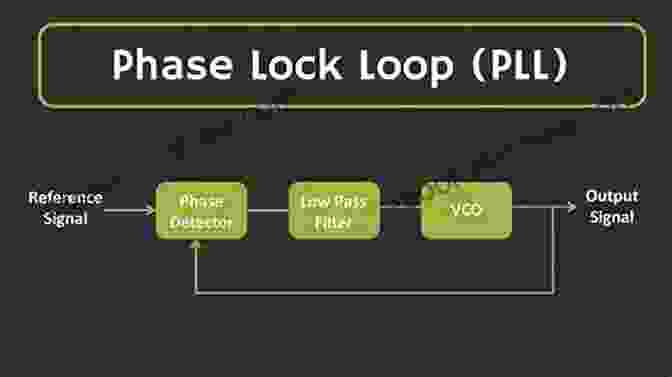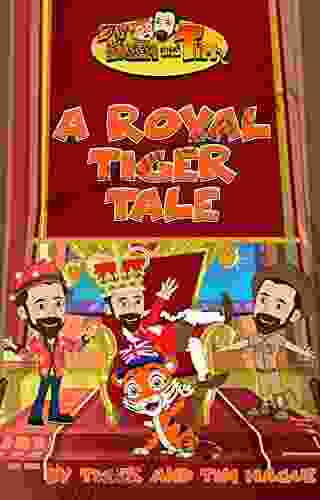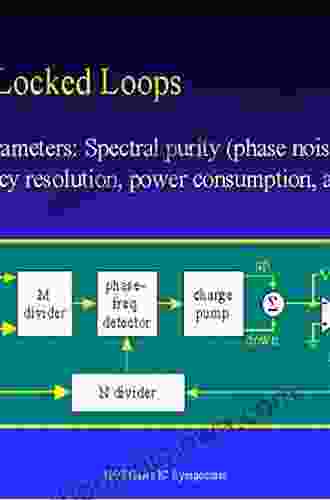Coupled Phase Locked Loops: Unlocking the Secrets of Precise Synchronization

In the ever-evolving world of electronics and communications, precision and synchronization play a critical role. Coupled Phase Locked Loops (CPLLs) have emerged as key players in this field, offering remarkable capabilities for synchronizing multiple oscillators or signals with unparalleled accuracy.
4.8 out of 5
| Language | : | English |
| File size | : | 22173 KB |
| Text-to-Speech | : | Enabled |
| Enhanced typesetting | : | Enabled |
| Screen Reader | : | Supported |
| Print length | : | 256 pages |
This comprehensive article delves into the fascinating world of CPLLs, exploring their fundamental concepts, design techniques, and cutting-edge applications. Whether you're an engineer, researcher, or simply intrigued by the intricacies of synchronization, this guide will provide valuable insights into the workings and significance of CPLLs.
Understanding Phase Locked Loops (PLLs)
Before delving into CPLLs, it's essential to understand their fundamental component: Phase Locked Loops (PLLs). A PLL is a feedback system that aligns the phase of an output signal with the phase of a reference signal. It consists of a phase detector, a filter, and a voltage-controlled oscillator (VCO).
The phase detector compares the phase difference between the reference and output signals and produces an error signal. The filter smooths out the error signal to remove noise and imperfections.
The VCO generates the output signal, and its frequency and phase are controlled by the error signal. The feedback loop ensures that the output signal maintains a fixed phase relationship with the reference signal.

What are Coupled Phase Locked Loops (CPLLs)?
Coupled Phase Locked Loops (CPLLs) extend the capabilities of PLLs by incorporating multiple VCOs or oscillators. These oscillators can be coupled together through various coupling mechanisms, such as mutual inductance or direct electrical connections.
The coupling among the VCOs introduces additional dynamics into the PLL system, leading to more complex synchronization behaviors. CPLLs enable the precise synchronization of multiple signals with different frequencies, phases, and even with non-sinusoidal waveforms.

Modeling and Analysis of CPLLs
Modeling and analysis are crucial steps in the design and implementation of CPLLs. Mathematical models, such as differential equations and state-space representations, capture the dynamic behavior of CPLLs, allowing engineers to predict their performance and stability characteristics.
Analytical techniques, including linearization and frequency-domain analysis, provide insights into the synchronization properties and loop dynamics of CPLLs. These tools help engineers optimize CPLL designs for specific applications.
Design and Implementation of CPLLs
Designing and implementing CPLLs involves selecting suitable VCOs, coupling mechanisms, and feedback algorithms. Engineers must consider factors such as synchronization range, stability, noise performance, and power consumption when choosing the appropriate components.
Circuit design techniques, including phase detectors and filters, are key to ensuring accurate synchronization and minimizing jitter. Digital implementation offers flexibility and programmability, allowing for real-time adjustments and adaptive control.
Applications of CPLLs
CPLLs find widespread applications across a diverse range of industries, including electronics, communications, and measurement systems:
- Frequency synthesis: Generating precise frequency signals with high stability and low phase noise.
- Clock recovery: Extracting the timing information from a data stream for synchronization and clock regeneration.
- Spread spectrum modulation: Spreading the bandwidth of a signal to enhance resistance against interference.
- Synchronization of multiple clocks: Maintaining precise timing relationships between multiple devices or systems.
- Phase noise reduction: Suppressing unwanted phase fluctuations in oscillators and signals.
Advantages and Limitations of CPLLs
Like any technology, CPLLs offer both advantages and limitations:
Advantages:
- Exceptional precision and accuracy in synchronization.
- Wide synchronization range and flexible frequency control.
- Noise suppression and jitter reduction capabilities.
- Compact size and low power consumption in integrated circuit implementations.
Limitations:
- Complexity in design and implementation compared to single PLLs.
- Potential for instability if not designed and tuned carefully.
- Noise and temperature sensitivity in some applications.
Future Trends in CPLL Research and Development
CPLL research and development continue to drive advancements in synchronization technologies:
- Synchronization of chaotic signals: Exploring CPLLs for synchronizing chaotic and random signals for secure communications and encryption.
- Ultra-low noise CPLLs: Developing CPLLs with ultra-low phase noise performance for precision measurement instruments and quantum computing.
- Digital and software-defined CPLLs: Implementing CPLLs in digital or software-defined platforms for enhanced flexibility and real-time control.
Coupled Phase Locked Loops (CPLLs) are powerful synchronization tools that have revolutionized the field of electronic circuits and communications. Their ability to synchronize multiple oscillators with unparalleled precision and flexibility has made them indispensable in a wide range of applications.
From frequency synthesis to clock recovery and spread spectrum modulation, CPLLs play a crucial role in ensuring reliable and efficient signal transmission, synchronization, and timing.
As research continues to push the boundaries of CPLL capabilities, we can expect even more innovative and groundbreaking applications in the years to come.
4.8 out of 5
| Language | : | English |
| File size | : | 22173 KB |
| Text-to-Speech | : | Enabled |
| Enhanced typesetting | : | Enabled |
| Screen Reader | : | Supported |
| Print length | : | 256 pages |
Do you want to contribute by writing guest posts on this blog?
Please contact us and send us a resume of previous articles that you have written.
 Book
Book Novel
Novel Page
Page Chapter
Chapter Text
Text Story
Story Genre
Genre Reader
Reader Library
Library Paperback
Paperback E-book
E-book Magazine
Magazine Newspaper
Newspaper Paragraph
Paragraph Sentence
Sentence Bookmark
Bookmark Shelf
Shelf Glossary
Glossary Bibliography
Bibliography Foreword
Foreword Preface
Preface Synopsis
Synopsis Annotation
Annotation Footnote
Footnote Manuscript
Manuscript Scroll
Scroll Codex
Codex Tome
Tome Bestseller
Bestseller Classics
Classics Library card
Library card Narrative
Narrative Biography
Biography Autobiography
Autobiography Memoir
Memoir Reference
Reference Encyclopedia
Encyclopedia John Robert
John Robert Juan G Roederer
Juan G Roederer Laura Ingalls Wei
Laura Ingalls Wei Nina Revoyr
Nina Revoyr Kim Addonizio
Kim Addonizio Otto Gasser
Otto Gasser Lawrence Bee
Lawrence Bee Matt Addison
Matt Addison Sam Knowles
Sam Knowles Jonathan Clifford
Jonathan Clifford Jonathan Dehart
Jonathan Dehart Josepha Sherman
Josepha Sherman Nolan R Wallach
Nolan R Wallach Vicky Y W Wong
Vicky Y W Wong Julia Jones
Julia Jones Jon Tucker
Jon Tucker Jenny Oliver
Jenny Oliver Jonathan Chatwin
Jonathan Chatwin Marilynn R Glasser
Marilynn R Glasser Julian Hunt
Julian Hunt
Light bulbAdvertise smarter! Our strategic ad space ensures maximum exposure. Reserve your spot today!

 Levi PowellSmall Group Math Instruction: Strategies to Differentiate Elementary Lessons...
Levi PowellSmall Group Math Instruction: Strategies to Differentiate Elementary Lessons... Edward ReedFollow ·19.3k
Edward ReedFollow ·19.3k Paulo CoelhoFollow ·6.6k
Paulo CoelhoFollow ·6.6k Steven HayesFollow ·15.6k
Steven HayesFollow ·15.6k Mario Vargas LlosaFollow ·16k
Mario Vargas LlosaFollow ·16k Camden MitchellFollow ·9k
Camden MitchellFollow ·9k Floyd RichardsonFollow ·12.8k
Floyd RichardsonFollow ·12.8k W.B. YeatsFollow ·12.4k
W.B. YeatsFollow ·12.4k Ervin BellFollow ·16.6k
Ervin BellFollow ·16.6k

 José Martí
José MartíUnleash the Magic Within: "That's Not a Hippopotamus,...
Step into a Realm Where...

 Cristian Cox
Cristian CoxWhere Is Thumbkin? A Journey Through Beloved Children's...
In the realm of...

 Jason Reed
Jason ReedWitness the Unforgettable Journey of "Royal Tiger Tale":...
: Embark on an extraordinary literary...

 David Baldacci
David BaldacciRicky's Dream Trip to Ancient Greece: An Unforgettable...
Embark on an Epic Journey Get ready...

 Ira Cox
Ira CoxUnleash the Freckled Venom: Embark on an Enchanting...
Dive into the Extraordinary...
4.8 out of 5
| Language | : | English |
| File size | : | 22173 KB |
| Text-to-Speech | : | Enabled |
| Enhanced typesetting | : | Enabled |
| Screen Reader | : | Supported |
| Print length | : | 256 pages |












